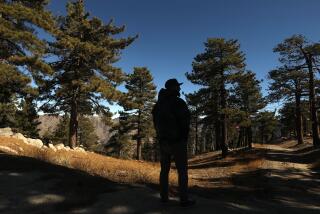Santa Monica Mountains--Parkland Dream Dying on the Vine
- Share via
Spring in Corral Canyon on the Malibu coast brings the flowering of golden yarrow and the aroma of purple sage, the emergence of yucca spikes and the languid breeze pushing ripples of wild oats on steep hillsides. Owing to its stark majesty, its botanical value and its strategic position as an open-space corridor from the beach to the heart of the Santa Monica Mountains, Corral Canyon was originally deemed essential to the Santa Monica Mountains National Recreation Area. Now, however, it is just one of many ecologically important parcels that have been dropped from the National Park Service priority acquisition list.
Park Service director William Penn Mott Jr. took another look at Corral Canyon last month, but not before he testified before the House Appropriations subcommittee, recommending that future federal land purchases in the Santa Monicas be limited to inexpensive high ridges in the nearly inaccessible Zuma Canyon. He also asked that a limit be placed on money for the amount of land that the government will buy for environmental protection.
These policies, previously proposed by former Interior Secretary James Watt, would eventually lead to declassification of the recreation area as a national park and the departure of the Park Service staff. Congress would then have no incentive to appropriate funds to complete the park.
Fortunately, official efforts in Washington to engineer ever-narrower boundaries for the recreation area have been largely unsuccessful. The Santa Monicas remain, as they always have been, a “people’s park.” In fact, the original vision of the park--a unique combination of city, county, state and federal land, together with beach, trails and scenic corridors, running from Griffith Park to Pt. Mugu--was conceived by the Friends of the Santa Monica Mountains and a grass-roots movement of Southern Californians.
Supporters realize that only the federal government has the scope and resources to create a first-class park. But while Congress authorized $155 million for land purchase in 1978, less than half has been appropriated. Although President Reagan is a Southern Californian, it has been a congressman from Chicago, Sidney R. Yates, chairman of the appropriations’ subcommittee on the Interior, who has allowed the expenditure of $75 million for recreation-area land, about a quarter of what is now needed.
The Reagan Administration’s effort to end federal land purchase in our mountains is echoed locally in the continuing opposition to the park by developers in Los Angeles County, although neighboring cities in Ventura County have been supportive. As land costs rise and the Administration presses for a park that is smaller and less accessible to the public, environmentalists find themselves divided on how to spend the limited funds available. Most of them agree, however, that Park Service priorities for land purchase should remain flexible, responsive to changing development threats to land availability.
Although the Santa Monica Mountains National Recreation Area is still unfinished, it must not be abandoned. Other parks have taken decades to complete. Cape Cod National Seashore, established in 1961, received appropriations as late as 1980. Ohio’s Cuyahoga National Recreation Area, established in 1974, continues to get money from Congress.
Enormous strides have been taken since the Santa Monicas park was envisioned in 1963, when there was virtually no public recreation land west of Sepulveda Pass. The Santa Monicas now contain 12,600 acres of federal land (of the 55,000 key acres originally proposed) and more than an additional 50,000 acres of other public and private open space. Another 10 or 15 years of sustained commitment could complete the park.
Congress needs to hear that Southern California wants:
--A higher acquisition budget for the recreation area as part of a general increase in the National Park Service budget.
--Immediate purchase of land endangered by development or foreign purchase, including upper Topanga Canyon, Corral Canyon, Medea Valley (site of the Renaissance Pleasure Faire), Cold Canyon and the Presbyterian Conference Grounds in Temescal Canyon.
--Appropriate use of eminent domain where development threatens, excluding settled areas.
--Recognition of archeological, biological, ecological and cultural values in setting acquisition priority.
When the original vision of the recreation area is restored, it will be because park advocates now represent a broad base of Southern California constituents. Voices demanding a halt to the mauling and paving and manor-ization of the Santa Monicas are coming from people who actually use the park--new mountain residents and visitors from the inner city, young people and hikers, bicyclists and equestrians and leisure-time motorists who have finally discovered the mountains’ wild beauty.
More to Read
Sign up for The Wild
We’ll help you find the best places to hike, bike and run, as well as the perfect silent spots for meditation and yoga.
You may occasionally receive promotional content from the Los Angeles Times.






